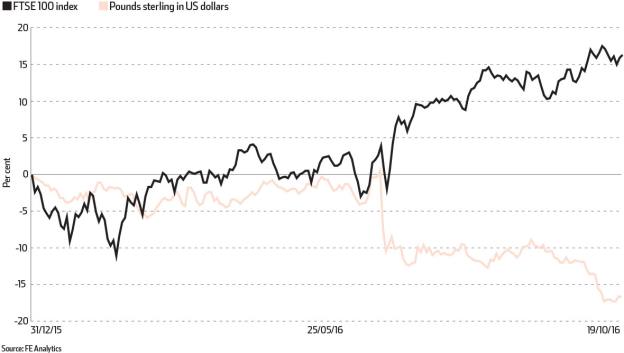

The UK stockmarket has experienced a relatively smooth time of it since the EU referendum result in June laid the foundations for the UK’s exit from the bloc.
Initial falls in the market were recouped and fears of a full-blown recession have receded as economic data appears stable. September UK retail sales figures remain unchanged since August, showing a 4.1 per cent increase compared with September 2015.
There are of course some flies in the ointment, most notably the slump in sterling against the dollar, which is causing anxiety for some investors regarding higher import prices for domestically focused firms.
But while these businesses may struggle with the weaker currency, many of the FTSE 100 index constituents that generate a large proportion of their earnings overseas are reaping the benefits. As sterling has dropped 16.7 per cent against the dollar for the year to date to October 19, the FTSE 100 has risen 16.3 per cent, data from FE Analytics shows.
While this is good news for some UK investors, there are reasons to be cautious when considering the boosts from a weaker sterling.
James McCann, UK and Europe economist at Standard Life Investments, says it is important to remember why the pound has fallen so sharply. “If exit from the EU leads to material trade frictions, this is likely to have a larger effect on the UK’s longer-term growth prospects. Second, there are other less helpful side effects from currency adjustments. Textbooks tell us that a weaker currency will push up inflation by raising import prices – weighing on households’ real incomes,” Mr McCann adds.
“Sterling’s weakness after the financial crisis was one of the factors that led to the largest squeeze on real wages in a generation. Our findings suggest a 10 per cent depreciation in the effective exchange rate would push the CPI [consumer prices index] 2.6 percentage points higher than it would otherwise be over a four-year period. With household consumption accounting for almost two-thirds of UK GDP, the risk could be that the net effect of a weaker currency is negative.”
Inflation is already starting to tick up, with the Office for National Statistics recording CPI at 1 per cent in September up from 0.6 per cent in August. While the drop in sterling is not highlighted as a key driver for the rise, this may change if the currency continues to weaken.
Analysts at Whitechurch Securities note: “If the weakening in sterling is not responsible for the inflation up-tick, then expect inflation to rise even further. Sterling has fallen by more than 17 per cent against the US dollar since the Brexit vote. This will lead to further price increases in clothing, food and fuel, which could result in inflation rising above the 2 per cent target and start outpacing wage growth. It is at this point that inflation could become a real problem.”
Anthony Rayner, manager of Miton’s multi-asset fund range, agrees inflationary pressures are building in the UK: “The materially weaker post-Brexit pound is leading to higher import costs, already seen in sharp increases in the prices of materials and fuels bought by UK manufacturers. We expect this to continue.”
For investors, the mixed data picture that is emerging of the post-referendum economy is proving to be tricky to navigate, especially when no one is sure about what will happen next.
Year-to-date performance of the FTSE 100 index versus sterling




